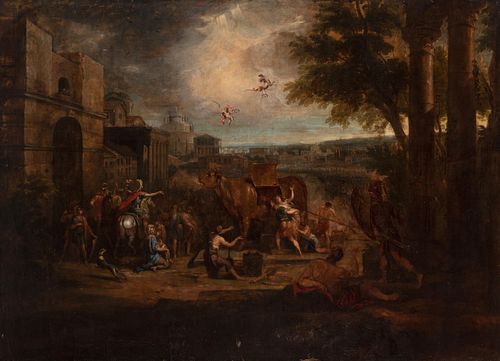Italian school; XVIII century. "Bull of Faralis". Oil on canvas.
Lot 102
About Seller
Setdart Auction House
Carrer Aragó 346
Barcelona
Spain
Setdart Subastas was born in 2004 and is currently the first online art auction in Spain with solidity, prestige and reliability guaranteed by our more than 60,000 users. Setdart has a young, dynamic and enterprising team ready to successfully manage the purchase and sale of art works through custom...Read more
Estimate:
EUR€7,000 - EUR€8,000
$7,526.88 - $8,602.15
Absentee vs Live bid
Two ways to bid:
- Leave a max absentee bid and the platform will bid on your behalf up to your maximum bid during the live auction.
- Bid live during the auction and your bids will be submitted real-time to the auctioneer.
Bid Increments
| Price | Bid Increment |
|---|---|
| EUR€0 | EUR€10 |
| EUR€200 | EUR€25 |
| EUR€500 | EUR€50 |
| EUR€1,000 | EUR€100 |
| EUR€3,000 | EUR€200 |
| EUR€5,000 | EUR€500 |
| EUR€10,000 | EUR€1,000 |
| EUR€20,000 | EUR€2,000 |
| EUR€50,000 | EUR€5,000 |
About Auction
By Setdart Auction House
Oct 20, 2021
Set Reminder
2021-10-20 07:30:00
2021-10-20 07:30:00
America/New_York
Bidsquare
Bidsquare : OLD MASTERS
https://www.bidsquare.com/auctions/setdart-auction-house/old-masters-7700
Setdart Auction House sofia@setdart.com
Setdart Auction House sofia@setdart.com
- Lot Description
Italian school; XVIII century. "Bull of Faralis". Oil on canvas. Presents frame of the nineteenth century and an addition, in addition to patches, faults and repainting. Size: 191 x 262 cm; 205 x 277 cm (frame). Through the use of a classical language and historicist conception, the author presents us with a composition, which is based on fantasy and the reinterpretation of the classical world. As the protagonist of the scene, an enormous bronze bull occupies the central area of the image. It is the famous "Bull of Falaris (Phalaris)", also known as the Sicilian bull. This bronze sculpture was a well-known instrument of torture, designed in ancient Greece. After its invention it was presented to the Sicilian tyrant Phalaris, as a means to terminate criminals. Designed with the same dimensions as a real bull, the sculpture had a device that transformed the cries of the tortured into bull moos. These were introduced into the interior of the sculpture, which was heated by a fire located on the outside, which heated the metal. In the image, a woman is forcibly introduced inside the bull, in whose entrails the flames of the fire can be seen, a characteristic that shows the artist's personal reinterpretation of this theme. A large group of people, representing different social classes, swirl around the left side of the composition to contemplate the main scene. The set that develops in a landscape, stands out for the architectural presence, where you can identify buildings such as the arch of Julius, the Mausoleum of Augustus and Hadrian's temple. It is interesting to note the presence of two little love birds, in the background of the scene. Both carry a crown of flowers and a palm, which is the iconographic symbol that usually accompanies the martyrs. Therefore, it is probable that the scene represents the martyrdom of one of the first Christians, who confronted the prevailing polytheistic religion of the Greco-Roman society. The figures that make up the scene have been conceived following the aesthetics of classicism, with a very marked humanist perspective. The harmony of classicism can be seen in the attitudes of the characters contemplating the scene, in contrast to the dynamism of the figure that is to be tortured. This harmony is also reflected in the palette chosen by the painter, very lively, but without excessive contrasts in the coloring or in the light sources used. The historical theme is set in a glorious past, sometimes related to the history of the painter's country.
- Shipping Info
-
In-house shipping available. Please inquire at admin@setdart.com.
-
- Buyer's Premium



 EUR
EUR CAD
CAD AUD
AUD GBP
GBP MXN
MXN HKD
HKD CNY
CNY MYR
MYR SEK
SEK SGD
SGD CHF
CHF THB
THB











